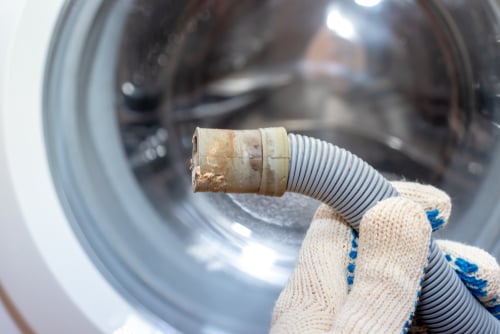If your house has natural gas, you have a main shut off valve. And learning the location of your shut off valve could save your life. It’s not as simple as just flipping a switch, there are careful safety precautions to consider. With this article, we’re going to walk you through the process of finding and identifying your valves. We’ll also cover some important safety essentials, so be sure to read through all the way!
Gas valves can vary in location, shape, and number depending on the age of your house. Learning the location of your shut off valve could save your life. If you don’t know where your gas valve is, check:
- A street side valve: Next to the gas meter, this is the main shut off point.
- A house side valve: Located inside your house where the pipe enters your house. This ball valve should be attached to a black iron pipe.
- High-pressure systems: Newer homes with high pressure gas systems have gas shut-off valves located near the water heater or furnace.
- All gas appliances should have a shut off within 6 feet and be easily accessible.
Once located, it is recommended you label them because in the event of repairs, installations or emergencies, you will want to be able to stop the flow of gas to your appliances quickly.
Safety First
It’s not always safe to turn these valves off in an emergency. If you’re dealing with a gas leak and the gas hasn’t been leaking long, shut off the valve and get out. Not sure how long the gas has been leaking? The same rule applies - clear everyone out and call the gas company or fire department. When dealing with a gas leak, it’s always wise to exercise a copious amount of caution and contact the proper help.
Location of Gas Valves
Gas valves aren’t conversation pieces. You’re not going to find them in prominent, high traffic areas of your house. Additionally, gas valves can vary in location, shape, and number depending on the age of your house. Legal codes and your location can also play a role in where they are found. We’re going to walk you through the process so you will know how to safely and securely shut off your gas.
Types of Gas Valves
- Street Side Valve
- Your main shut off valve is located just before the gas meter. This is called your “street side valve”.
- House Side Valve
- On the inside of your house, where the pipe enters your house, you can find your “house side valve.” This ball valve is attached to a black iron pipe. Note: you may also see a gray galvanized pipe located nearby, this is your water pipe.
- High-Pressure Systems
- If you have a newer home, you will find a flexible copper pipe running from the meter to your utility room – this is an indicator that you have a higher pressure gas system. If this is the case, your main shutoff valve is more than likely located near your water heater or furnace.
Label Your Valves
Okay, now that you’ve tracked down your valves – label them. This goes for all of your valves, not just your main shutoff. In the event of repairs, installations or emergencies, you want to be able to stop the flow of gas to your appliances quickly.
How to Shut Off Your Gas Valve
So now that you know where your valves are located, and you’ve labeled them, let's talk about shutting them off. The long side of your handle is parallel to the incoming gas line, which means your gas in on and flowing. By turning the handle perpendicular to the incoming pipe, you are closing the valve and shutting off the gas. The same applies to single-lever ball valves with the handle parallel to the line meaning that gas is flowing.
Ready to take the next step in home ownership? Frontdoor® offers a variety of ways to get things done. Whether you prefer connecting via video chat with trade industry Experts, receiving a list of vetted Pros for repairs, or utilizing our how-to library to DIY, we've got you covered.
With the Frontdoor App, completing tasks has never been easier, so why wait? Open the Frontdoor and start taking control of your home repairs. Download the app today!
Frontdoor assumes no responsibility, and specifically disclaims all liability, for your use of any and all information contained herein.
Was this article helpful?






